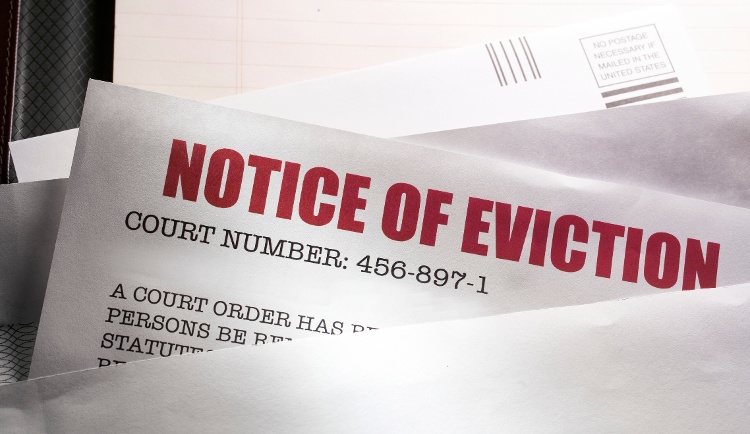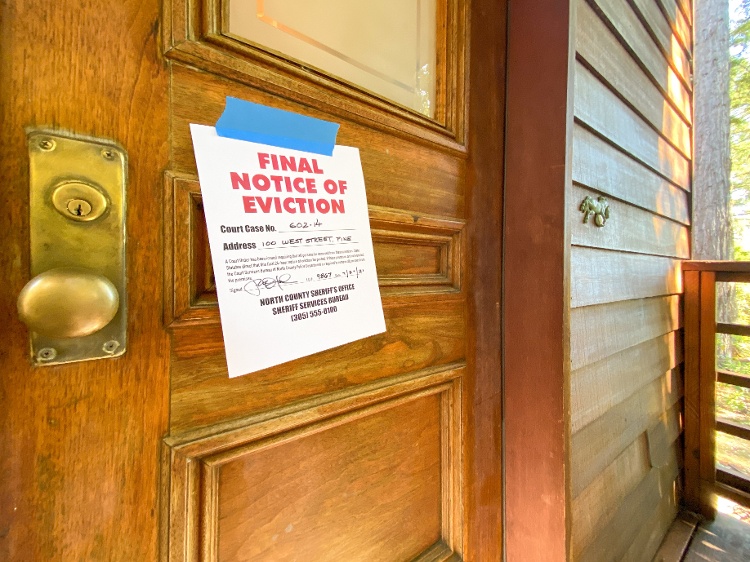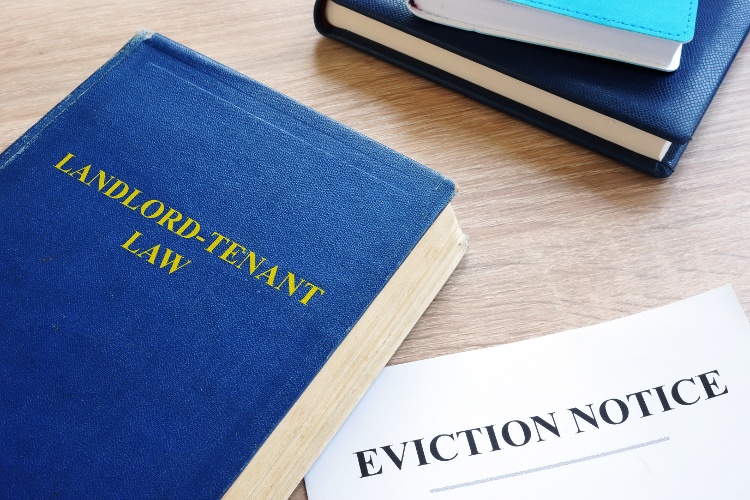According to a recent report from the United Nations, 3.6 million eviction cases are filed in the U.S. each year on average, resulting in approximately 1.5 million eviction judgments annually. Despite doing everything right, at some point in your rental property investing business you may be left with no option but to evict a tenant.
In this article we’ll explain how a residential eviction works, the costs involved in evicting a tenant, answer some common eviction FAQs, and discuss some good ways to avoid having to evict a tenant in the first place.
What is a Residential Eviction?
Eviction is the legal term for removing a tenant from a rental property. A residential eviction can occur at any time during the term of the lease, and also after the lease expires and the tenant refuses to vacate.
When a tenant is evicted their personal belongings and possessions are removed from the property. If the tenant is present at the rental property a law enforcement agency such as a sheriff, marshal, or the police are used to complete the residential eviction process.

Common Reasons for Evicting a Tenant
Reasons for evicting a tenant are determined by the terms and conditions of your lease with the tenant, and by the local landlord-tenant laws. In general, the most common reasons for evicting a residential tenant include:
- Failure to pay the rent in full and on time, even if the tenant is attempting to withhold rent because of unmade repairs.
- Violating a lease term or condition such as having unauthorized roommates or pets.
- Expiration of the lease, also known as a “holdover tenant” in some states.
- Breaking the law, such as dealing drugs or repeatedly violating a local nuisance ordinance.
- Misusing the property by intentionally creating minor or major damage to the interior or exterior of the dwelling.
Steps in the Residential Eviction Process
Landlords and property managers representing the landlord must follow the law when evicting a tenant. Eviction laws come from the local landlord-tenant rules and may also be based on judges’ rulings affecting how residential eviction laws are applied.
A landlord must also have a valid and legal reason for evicting a tenant, such as failure to pay the rent or the property being used for illegal purposes.
1. Speak with the tenant
Before beginning the eviction process it’s a good idea to talk to your tenants if you haven’t already. You may be able to reach a win-win solution and avoid the time and expense of evicting the tenant.
If you do reach an agreement, be sure to document it in writing, and signed by you and your tenant. Of course, speaking with the tenant may not work, but at least you’ll be able to tell the judge you’ve taken this step as an extra courtesy, assuming you end up taking the tenant to court.
2. Prepare the Eviction Notice
Each state uses a different format and requirements for a written Eviction Notice, also known as a Notice to Quit in some states. If the notice you use is “defective,” meaning that it does not meet the requirements of the state’s laws, you will have trouble removing the tenant.
An Eviction Notice should include information such as the total amount owed (including applicable late fees, penalties, and interest) and the deadline to pay or move out.
In many cities, attorneys who specialize in residential evictions offer a free legal Eviction Notice form to download from their websites. Other online sources for residential eviction templates by state include eForms and Rocket Lawyer.
3. Serve the Eviction Notice
The third step in the residential eviction process is to serve or deliver the notice to the tenant. An Eviction Notice must be served the required number of days before filing the eviction paperwork with the court, and the manner in which the notice is served must also comply with state law.
Some of the most common ways of serving an Eviction Notice include personal delivery with a witness, taping the Eviction Notice to the tenant’s front door, and sending the notice using both First Class Mail and Certified Mail with a return receipt requested to prove the notice was delivered.
Many landlords use more than one method for serving an Eviction Notice to eliminate the tenant’s excuse that they were never served.
4. Sue for forcible entry and detainer
At this point in the eviction process, the tenant may decide to willingly vacate the rental unit to avoid being taken to court. However, if the tenant is still there, your next step is to file your eviction with the court.
You will need to pay a fee at the local courthouse and prove the Eviction Notice was served in accordance with state law. The court will issue a summons and complaint to the tenant informing them they are being sued, and schedule a time for the court to hear the eviction case.
5. Take the tenant to court
Oftentimes a tenant will leave the property after being served with a summons. If they don’t, you will need to go to court for the eviction hearing, which could be 30 days or more from the time you first file an eviction lawsuit against the tenant.
Eviction hearings normally go very quickly, provided that the paperwork and evidence are in order and the facts of the case are straightforward. Many courts have judges who handle only residential eviction cases, so they are used to hearing every imaginable excuse a tenant might give.
The judge will examine evidence including the lease agreement, payment records, correspondence between you and the tenant, and proof the Eviction Notice was properly delivered.
After examining the evidence and hearing what both sides have to say, the judge will render a verdict and decide if the eviction is valid. If the landlord wins the tenant is given a specific time to move out. If the tenant wins, the tenant can stay in the property, normally subject to conditions or restrictions from the court.
If the tenant ignores the summons and doesn’t show up for the court hearing, a judge may decide in favor of the landlord.
6. Apply for Writ of Possession
Even if the judge has ruled in your favor and you win the eviction lawsuit, some tenants will still refuse to vacate the property. If this occurs you will need to ask the court for a Writ of Possession, also called a Writ of Recovery or a Writ of Restitution in some states.
After issuing the Writ of Possession, the court will instruct the sheriff or local law enforcement to physically enter the property in the presence of the landlord or property manager and remove the tenant. Law enforcement may use force if necessary to remove the tenant from your property.
7. Collect past-due rent and damages
The final step in the eviction process is to collect past-due rent and money to pay for damage caused by the tenant. Some states combine a small claims lawsuit with an eviction lawsuit, while in other states you will need to file a separate claim and receive a judgment in your favor from small claims court for any money you are owed.
Once you receive a judgment allowing you to collect money that the tenant owes, you can hire a debt collector who specializes in residential collections to report the debt to the major credit bureaus, garnish the tenant’s wages, and even garnish their tax refund.
Most private debt collectors will take a percentage of the debt collected, and will also respond to any legal actions a tenant may take after being evicted, such as the tenant filing a motion with the court asking that the judgment be dismissed.
Residential Eviction FAQs
1. How does a landlord serve an eviction notice?An Eviction Notice is served when a landlord wants to terminate the residential rental agreement for cause, such as the tenant not paying rent or damaging the property. The rules for serving an eviction vary from state to state. The most common ways to serve an eviction notice include:
- The process server is a professional service that physically delivers the Eviction Notice to the tenant.
- Certified Mail with return receipt requested, with most states allowing the eviction process to proceed if the tenant refuses to accept or sign for the Certified Mail.
Landlords must follow the legal process for evicting a tenant from a rental property, including having a valid reason for eviction, giving the tenant fair warning, and delivering the Eviction Notice as dictated by state law. Landlords who conduct illegal evictions such as changing the locks or entering the rental property and disposing of the tenant’s belongings can be held liable for damages.
3. Where can I find landlord-tenant laws for each state?The last thing a landlord wants to do is have to start the eviction process all over again, or potentially be held liable for breaking the law. Three good resources for finding landlord-tenant laws for each state are:
- State Landlord-Tenant Laws from the legal resource website Nolo
- Landlord-Tenant Law interactive map from the American Apartment Owners Association (AAOA)
- Local Tenants Rights, Laws, and Protections from HUD (select state, then “Get Rental Help”)
The Centers for Disease Control and Prevention (CDC) issued an Agency Order to temporarily halt the eviction of certain residential tenants to prevent the further spread of COVID-19 on September 1st of last year, with the latest order extended until at least March 31, 2021.
Although the most recent stimulus bill does not extend the ban on national evictions, the president may extend the protection through an executive order. Many states and cities have also invoked local eviction moratoriums.
Nolo has created a chart that attempts to capture the most recent information on COVID-related tenant protections by state, county, and major cities, if applicable: Nolo.com/evictions-ban
5. Do tenants have to pay rent after being served with an eviction notice?Tenants don’t have to pay rent after being served with a notice of eviction, although any unpaid rent they owe may be added to the final judgment amount awarded by the court. If you do accept a rent payment from a tenant being evicted, your rights to proceed with the eviction end.
Sometimes tenants will make a partial rent payment with the promise to become current soon. If the tenant doesn’t pay the remaining balance as agreed, a landlord will need to start the eviction process all over again.
6. How much does an eviction cost?Research by TransUnion SmartMove found that total eviction-related costs for evicting a tenant average $3,500 with the eviction process taking between 3-4 weeks to complete from start to finish. Expenses related to evicting a residential tenant include legal fees, court costs, financial damages, property damages, and lost rental income.

How to Avoid Evicting a Tenant
You’ve probably heard the saying that “an ounce of prevention is worth a pound of cure.” That’s absolutely true when it comes to residential evictions. The best way to keep from having to evict a tenant is by avoiding problem tenants in the first place.
Landlords and property managers who conduct a thorough tenant screening process, including pulling the tenant’s credit score, conducting a background report, and running a rental history check can minimize the risk of renting to a bad tenant. Some of the best rental listing websites offer a free online tenant screening service for landlords, including creating and signing state-specific leases online.
Final Thoughts on Evictions
Although evicting a tenant is sometimes unavoidable, following these best residential eviction practices can help keep your rental property business running smoothly and profitably.
While no landlord wants to evict someone, sometimes it’s better to evict a bad tenant and look for a good one.











